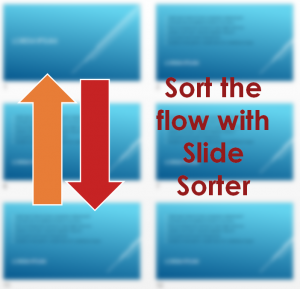Typically, we use the Slide Sorter view in PowerPoint to move, delete, or copy slides. Well, that’s what its function is. However, the Slide Sorter view has another implicit function for us as Instructional Designers – it’s an amazing tool to review the course flow. You can use this view to get a holistic picture of your course and check whether the course is flowing as you intended or if the current flow ensures that the course objectives are met or not. What’s the big deal, you say? You do all that in the Normal view anyway? Well, the answer to this is based on the Multimedia Learning theory’s Segmentation Principle.
 As per the Segmentation Principle of the Multimedia Learning theory, people process information better if it’s presented in smaller chunks or segments. In the normal slide view, cognitively, we can focus on just one slide; we may intend to check the course for flow, but due to the cognitive limitations of our brain, we may not be able to appropriately process the entirety of the course by looking at just one slide at a time. Whereas, the Slide Sorter view presents the flow of the course from the audience’s perspective. In addition, it lets you check the course for visual clarity and slide designs.
As per the Segmentation Principle of the Multimedia Learning theory, people process information better if it’s presented in smaller chunks or segments. In the normal slide view, cognitively, we can focus on just one slide; we may intend to check the course for flow, but due to the cognitive limitations of our brain, we may not be able to appropriately process the entirety of the course by looking at just one slide at a time. Whereas, the Slide Sorter view presents the flow of the course from the audience’s perspective. In addition, it lets you check the course for visual clarity and slide designs.
As Instructional Designers, we focus a lot on the cognitive limitations of our audience. However, we often forget that even we are an audience at some point, i.e., when we first familiarize ourselves with the course topics before we design/develop the training. The Slide Sorter view aids you in putting on a learner’s hat and assessing the course’s flow from their perspective. So, next time, before you finalize your course, take a step back, see the grand picture of your presentation in the Slide Sorter view of Microsoft’s PowerPoint, and review the course flow.





